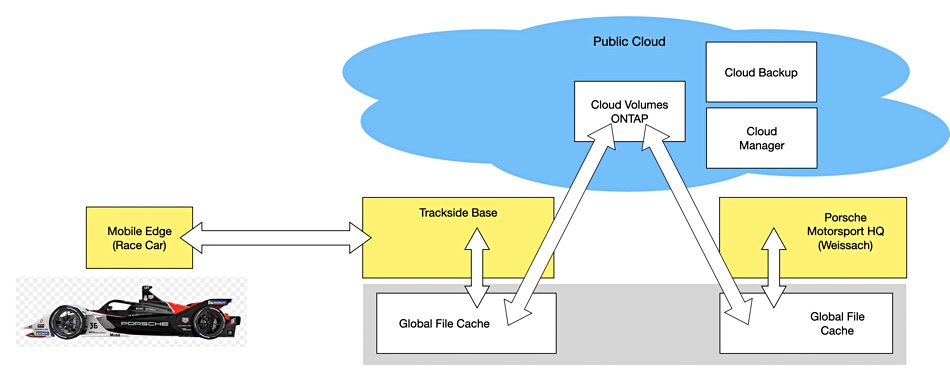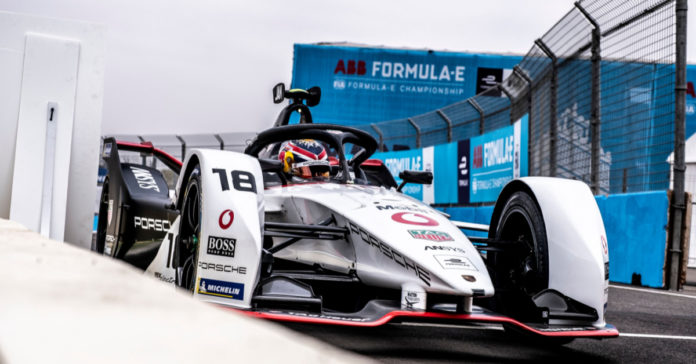NetApp and the TAG Heuer Porsche Formula E race car team are forming a “multi-year partnership” in which “NetApp will provide the sportscar maker with innovative hybrid cloud solutions that will help them continue to write car racing history.”
“NetApp’s hybrid cloud solutions enable TAG Heuer Porsche Formula E Team to access their data trackside to support driver and team performance. This helps them make data-driven decisions in real time.” Our first thought was that this was just typical IT-supplier-getting-sports-team marketing guff. But then we realized it was actually about the mobile edge, ROBO (remote office: branch office), and public cloud data sharing.
The race car is literally a mobile edge device. It generates data from onboard system sensors and sends them wirelessly to the race team’s remote office: its trackside base.
Real-time decisions have to be made at the trackside to help the car win the race and deal with situations such as overtakes. The driver cannot analyze the car’s overall situation in detail, but the trackside people can if they have access to reference information in a database.

In the NetApp-Porsche setup this information is stored in a cloud NAS: Cloud Volumes ONTAP. The trackside base sees part of this in its local edge device: a Windows server running NetApp’s Global File Cache (GFS). This caches “active” data in distributed offices – the trackside base in this example – so it can be used in collaboration situations needing fast local access. It features a global namespace with real-time central file locking.
The software creates a Virtual File Share at the ROBO location which looks and feels like a traditional file share. This file share presents centrally provisioned file shares in real time, while data is centrally stored on one or more file shares in Cloud Volumes.
NetApp says that typically clients provision <1TB of storage in a smaller office (<50 users), while others may reserve up to 5TB for cache in the largest offices of heavy users with large file formats. Active files remain persistently cached in the GFS edge instance, which saves on data movement across the WAN to Cloud Volumes ONTAP. We don’t envisage any data gravity problems with this setup.
Car-generated and other trackside data is encrypted and uploaded to Cloud Volumes ONTAP by GFS across a WAN link with compression, streaming and delta differencing (sending only changed data). We say Cloud Volumes ONTAP, but the central cloud silo could be Cloud Volumes Service or Azure NetApp Files, meaning AWS, Azure, and GCP are all supported. In Porsche’s case the Azure public cloud is used.
Data can be analyzed in the cloud and used to provide real-time (race time) decisions – such as when to use the Formula E Attack Mode, which unlocks an additional 30 kilowatts of engine power. Attack Mode engagement rules are set by the FIA admin body an hour before every ePrix race. Drivers can use the extra speed this gives them for a few laps when they need an edge.
Data protection (backups and archive) is done in the cloud, relieving the trackside base from that burden. A Cloud Manager product delivers centralized orchestration across this hybrid cloud storage infrastructure and data management services so admin staff can manage, monitor, and automate their data software and hardware consumption.
Staff in Porsche Motorsport HQ at Weissach also access the central cloud NAS data for post-race analysis and their general electric vehicle research and development initiatives.
Setting aside the Porsche and e-car racing glamor, what we have here are transitory ROBO sites set up (at race circuits) with data generated from far edge systems (race cars) and commands sent to them. These ROBO sites link to a cloud datacenter in a global file system which is accessed by a head office site as well. In other words, one ROBO site access period every month or so and head office access all the time. No big deal really. Cloud NAS analytics are used to inform the trackside ROBO strategy but not to operate the actual mobile edge devices – the race cars. Again, not that demanding.
Check out a Global File Cache FAQ here.








